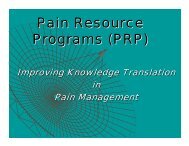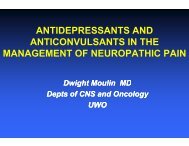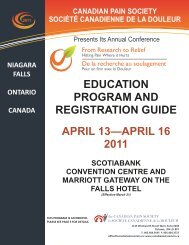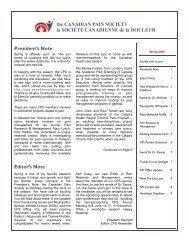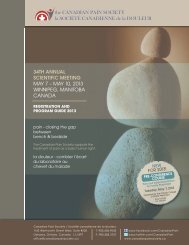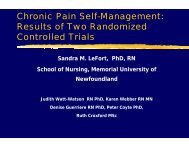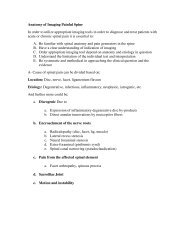Session 103 - Squire - The Canadian Pain Society
Session 103 - Squire - The Canadian Pain Society
Session 103 - Squire - The Canadian Pain Society
Create successful ePaper yourself
Turn your PDF publications into a flip-book with our unique Google optimized e-Paper software.
Opioids and the Regulators<br />
CPS 2008<br />
Victoria BC<br />
Dr Pam <strong>Squire</strong><br />
Dr Pam <strong>Squire</strong>
Disclosure<br />
• Paid speaker or advisor for:<br />
• Janssen Ortho<br />
• Purdue<br />
• Pfizer<br />
• Astra Zeneca<br />
• Valeant<br />
• Merck Frosst<br />
• Bayer<br />
• Paladin<br />
• Biovail<br />
• Ortho McNeil<br />
• Ortho Biotech
Objectives<br />
• To review what the regulators say they<br />
want<br />
• To review some suggestions for how to do<br />
what the regulators want<br />
• To discuss who should not be prescribing<br />
opioids
<strong>Pain</strong> Assessment<br />
<strong>Pain</strong> Assessment
PAIN RATINGS<br />
PAIN RATINGS
What the Regulators Say <strong>The</strong>y<br />
Want -Assessment<br />
• A diagnosis and failing that a mechanism<br />
(and document an appropriate physical exam)<br />
• <strong>Pain</strong> severity / aggravating and relieving factors<br />
• Psychiatric assessment<br />
• Psychosocial assessment<br />
• Risk assessment<br />
• Functionality Assessment<br />
Evidence-Based Recommendations for the Medical Management of Chronic Non-Malignant<br />
<strong>Pain</strong>.Reference Guide for Clinicians.Ontario College of Physicians and Surgeons.Nov 2000
Practical Tips for Assessment<br />
Practical Tips for Assessment<br />
• A diagnosis and failing that a mechanism<br />
(and document an appropriate physical exam)<br />
• <strong>Pain</strong> severity / aggravating and relieving factors<br />
1. Brief <strong>Pain</strong> Inventory - Short Form<br />
2. DN4-Questionnaire<br />
1.With permission: <strong>Pain</strong> Research GroupMD Anderson Cancer Center 1997<br />
2.Bouhassira D et al. <strong>Pain</strong> 2005;114:29-36
Coloured <strong>Pain</strong> Drawing<br />
<strong>Pain</strong> drawing key<br />
dull aching -yellow<br />
sharp - red<br />
tingling - green<br />
burning - blue
Practical Tips for Assessment<br />
Practical Tips for Assessment<br />
• Psychiatric assessment<br />
1. Beck Depression Inventory -PC (BDI-PC)<br />
2. Generalized Anxiety Disorder -7 scale (GAD-7)<br />
1.Beck AT, Guth D, Steer RA, Ball R. Screening for major depression disorders in medical inpatients<br />
with the Beck Depression Inventory for Primary Care. Behav Res <strong>The</strong>ra. 1997;35:785-91.<br />
2.Spitzer RL, Kroenke K, Williams JB, Lowe B. A Brief Measure for Assessing Generalized Anxiety<br />
Disorder: <strong>The</strong> GAD-7. Arch Intern Med. 2006;166(10):1092-7.
Practical Tips for Assessment<br />
Practical Tips for Assessment<br />
• Psychosocial assessment<br />
1. <strong>Pain</strong> Catastrophizing Scale<br />
2. Occupational History<br />
3. Coping strategies<br />
4. Readiness to change<br />
1. Sullivan MJL, Bishop S, Pivik J. <strong>The</strong> pain catastrophizing scale: development and validation. Psychol Assess<br />
1995; 7: 432-524.
Practical Tips for Assessment<br />
Practical Tips for Assessment<br />
• Risk assessment<br />
1. Screener and Opioid Assessment for Patients with<br />
<strong>Pain</strong> (SOAPP -14)<br />
2. Opioid Risk Tool<br />
1.Akbik H et al.Validation and clinical application of the Screener and Opioid Assessment for Patients with <strong>Pain</strong> (SOAPP).<br />
J <strong>Pain</strong> Symptom Manage. 2006 Sep;32(3):287-93.<br />
2. Webster LR, Webster RM.Predicting aberrant behaviors in opioid-treated patients: preliminary validation of the Opioid<br />
Risk Tool.<strong>Pain</strong> Med. 2005 Nov-Dec;6(6):432-42.
Practical Tips for Assessment<br />
Practical Tips for Assessment<br />
• Functionality Assessment<br />
1.<strong>Pain</strong> Disability Index Score<br />
1. Pollard CA.Percept Mot Skills.1984:984:59:974-981]
Practical Tips for Assessment-<br />
Documenting It.<br />
• A diagnosis and failing that a mechanism<br />
• Other significant medical history<br />
• Psychiatric assessment<br />
• Psychosocial assessment<br />
• Risk assessment<br />
• Functionality Assessment<br />
• Current and Past Treatment<br />
• Goals<br />
<strong>Squire</strong> P.Does Ineffective Communication Confound Multidimensional <strong>Pain</strong> Assessment. J of <strong>Pain</strong><br />
Dec 2007
Treatment-What the Regulators<br />
Want<br />
• Trial of non-opioids first<br />
• Increasing doses of appropriate opioids should<br />
be accompanied by increasing analgesic effect<br />
• Use long acting opioids and infrequent doses of<br />
breakthrough opioid dosing<br />
• Rare use of injectable opioids<br />
• Verbal or written contract<br />
• Reassess q 3 months (minimum) and document<br />
the 4 A’s - Analgesic efficacy,Adverse<br />
effects,Activity,Aberrant behaviours
How to Use Opioids Safely<br />
How to Use Opioids Safely<br />
• Be willing/able to do what it takes<br />
• Entrance and exit strategy<br />
• Urine Drug Testing<br />
• Informed Consent for Opioid Trial<br />
• Objective measurement of improvement<br />
• Document the 5A’s-<br />
1.<strong>Pain</strong> Management Progress Notes<br />
Gouraly G, heit H et al.Universal Precautions in <strong>Pain</strong> Medicine.<strong>Pain</strong> Medicine 2006<br />
Gourlay D, Heit H.Urine drug testing in Clinical Practice<br />
http://www.familydocs.org/files/UDTmonograph.pdf
Thank You Thank You<br />
Questions?



